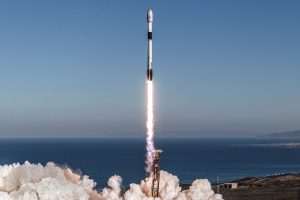On January 9th, SpaceX demonstrated the breadth of its capabilities by simultaneously operating two orbital Dragons, four rockets, and four launch pads.
In the afternoon, SpaceX stacked Ship 24 and Super Heavy B7 at Starship’s lone South Texas orbital launch pad. In California, a Falcon 9 rocket was vertical at Vandenberg Space Force Base for SpaceX’s upcoming Starlink 2-4 launch, which will carry the company’s own internet satellites. In Florida, both of SpaceX’s orbital Falcon launch pads were occupied.
A Falcon Heavy rocket had just gone vertical at Kennedy Space Center Pad 39A, which SpaceX leases from NASA. A few miles to the south, a second Falcon 9 rocket was vertical at SpaceX’s Cape Canaveral Space Force Station LC-40 pad for a OneWeb satellite launch. While weather delayed Starlink 2-4, SpaceX was briefly prepared to launch both Falcon 9 rockets just 35 minutes apart.
In low Earth orbit, around 400 kilometers (250 mi) up, a Cargo Dragon 2 spacecraft was freely flying in space shortly after undocking from the International Space Station (ISS). Simultaneously, a Crew Dragon spacecraft was docked to the ISS, where it will remain until it returns four astronauts to Earth in February 2023.
For a moment, SpaceX simultaneously had four orbital-class rockets assembled and vertical at all four of its orbital launch pads, and two reusable Dragon spacecraft operating in orbit. Only the entire Chinese launch industry, private and public, can hold a candle to the breadth and diversity of the launch vehicle and spacecraft operations of a single company. All the while, SpaceX was operating more than 3300 Starlink satellites in orbit and serving internet to a million customers around the world.
On the horizon, SpaceX has contracts with NASA to launch modified Dragon spacecraft to lunar orbit, land astronauts on the Moon with a modified version of Starship, and send private astronauts around the Moon on Starship. Starship’s ultimate purpose is to enable the construction of a permanent, sustainable human presence on Mars.
SpaceX has a long way to go to achieve those extraterrestrial goals. But a decade ago, even the company’s most optimistic proponent could scarecely have dreamt that SpaceX would dominate almost every major segment of modern spaceflight (satellites, rockets, private astronauts, space station cargo/crew) by the early 2020s. Nor would they have expected that SpaceX would beat Boeing to its first astronaut launch, or that NASA would place its trust (and billions of dollars) in Starship – beating out almost every other major traditional US aerospace company – to return humanity to the Moon. Only time will tell where the company will be another decade from now, let alone later this year.





